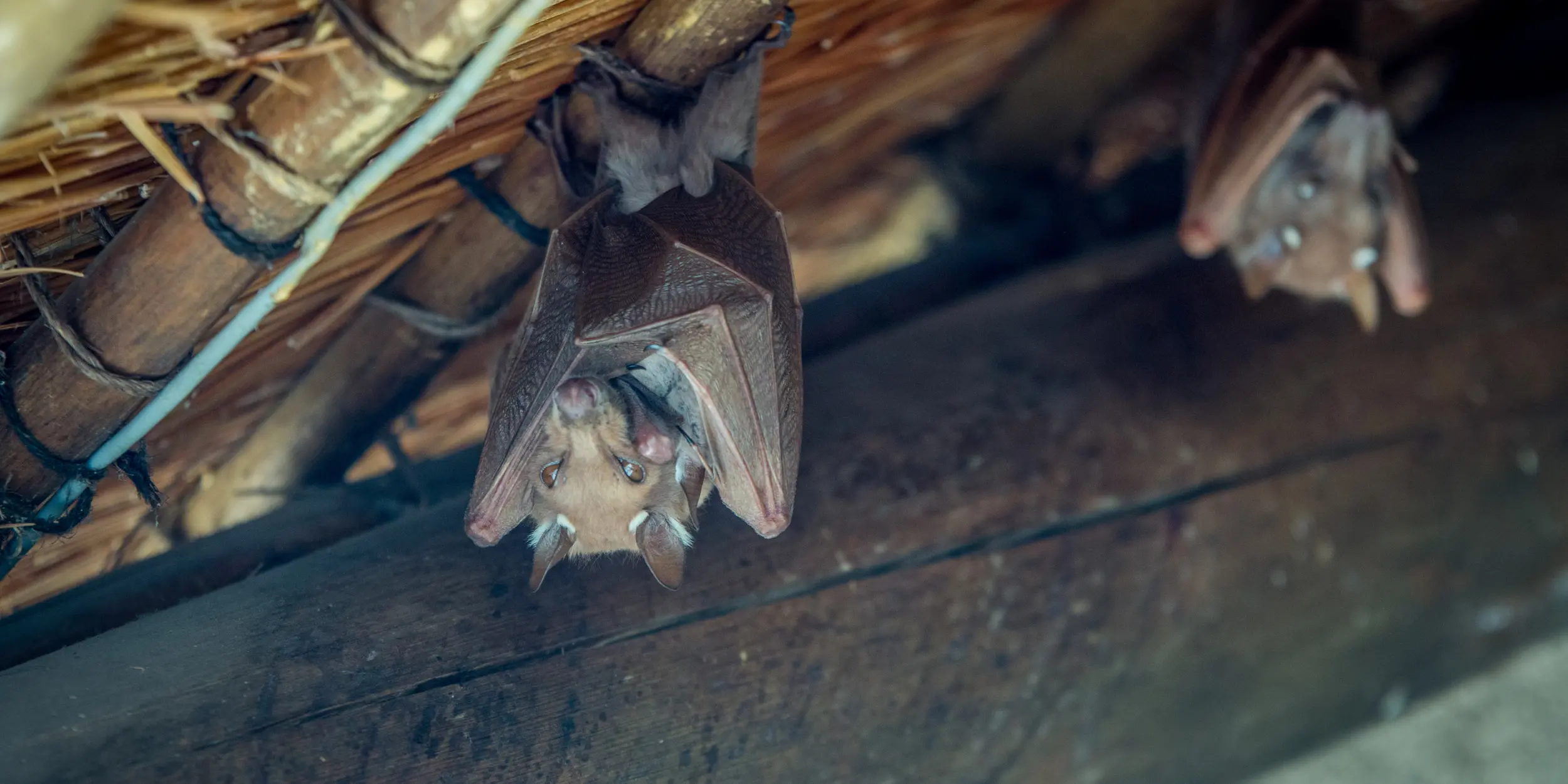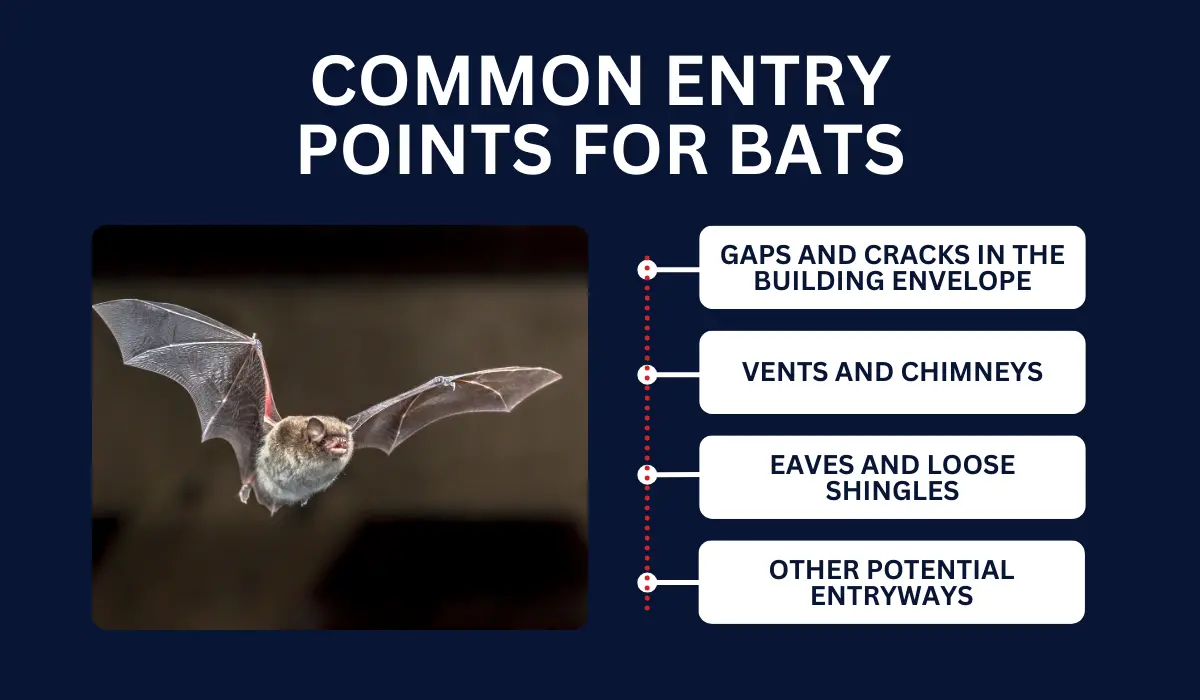
Ever wondered how a bat ends up in your living area? Bats can enter your home through tiny openings as small as half an inch. They use gaps around windows, doors, and vents to sneak inside. Even chimneys and attic vents are common entry points.
Are there unseen cracks or gaps in your home’s exterior that could serve as a potential bat entrance? Keep reading to find out how to bat-proof your house and avoid unexpected winged guests.
Key Takeaways
- Bats can enter homes through narrow gaps around doors, chimneys, and joints between building materials; regular inspections and repairs of roofs, eaves, and shingles are crucial to deter their roosting.
- Effective bat prevention includes sealing potential entry points such as roof gaps, open vents, and wall cracks.
- Utilizing humane bat exclusion methods and professional wildlife removal services ensures safe and effective bat removal and prevention.
COMMON ENTRY POINTS FOR BATS

Bats in Louisiana can enter homes through various small openings and building structures. So, identifying these critical spots is crucial in preventing bats from making your home their roosting spot.
Gaps and Cracks in the Building Envelope
Bats often find their way into houses through gaps and cracks in the building envelope. These entry points can be pretty small, as bats only need a half-inch gap to gain entry:
- Gaps around doors and windows
- Gaps around the flue
- Cracks in walls or foundations
- Small Openings around pipes or wiring that enter the building
- Areas where different building materials connect
Vents and Chimneys
Vents and chimneys are attractive entry points for bats because they provide a direct route into homes. These areas are often overlooked in bat-proofing with chimney caps, making them prime targets:
- Chimney openings
- Dryer and exhaust vents
- Attic vents
- Bathroom vents
Eaves and Loose Shingles
Eaves and shingles allow bats to slip into attics and walls easily. Regular roof inspections and maintenance can prevent bats from roosting in spots like:
- Eaves gaps
- Broken or loose shingles
- Damaged fascia boards
- Spaces where soffits meet the roofline
Other Potential Entryways
Besides common structural gaps, bats may enter homes through other overlooked areas. To help reduce bat entry, include these areas when securing the home:
- Open window sills
- Weatherstripping
- Ridge vents
- Attic fans
WHAT ATTRACTS BATS TO BUILDINGS?
Accessibility of Entry Points
Bats are skilled at finding and exploiting even the tiniest entry points in buildings. They typically look for:
- Small Openings: Gaps as small as 1/2 inch in diameter can allow bats to enter.
- Open Windows & Doors: Windows and doors left open or not properly sealed.
- Roof Eaves: Gaps and spaces under roof eaves.
- Chimneys: Unscreened or open chimneys providing a direct route inside.
Availability of Food Sources
Bats are primarily insectivores in the ecosystem. They find buildings near these habitats to be convenient living quarters due to nearby or abundant food sources, such as
- Insects: Moths, beetles, and mosquitoes.
- Water Bodies: Lakes or ponds nearby, which attract insect populations.
- Gardens and Trees: Fruiting trees and flowering plants increase insect activity.
SIGNS OF BAT INFESTATION
Physical Indicators
Physical signs are often visible first in a colony of bats. To better identify the presence of bats in your area, observe the following:
| Physical Indicators | Description |
|---|---|
| Bat Guano (Feces) | Small, dark droppings near entry points and roosting sites. |
| Stains Near Openings | Brownish, oily stains left by bats entering through gaps. |
| Bat Urine | Pungent odor and staining around roosting sites or pathways. |
Noises and Odors
Auditory and olfactory signs can also reveal a bat infestation. Bats are primarily nocturnal and tend to be active at dusk. Listen and look for the following:
| Noises and Odors | Description |
|---|---|
| Squeaking Sounds | High-pitched noises, often at dusk or dawn. |
| Scratching Noises | Audible movement within walls or ceilings during the night. |
| Musky Odor | Strong, unpleasant smell from bat droppings and urine. |
HOW TO PREVENT BATS FROM INVADING YOUR HOME
Seal Up Potential Entry Points
Many homes have small cracks, gaps, or openings that can serve as entry points for bats. Inspect and seal common entry points, such as:
- Gaps in roofing and shingles: Use caulk or a foam sealant.
- Open vents or chimneys: Install caps or mesh covers.
- Cracks in walls or foundations: Apply caulk or concrete patch.
- Spaces around windows and doors: Weatherstripping or sealant can help seal these areas.
Make Your Home Less Appealing to Bats
Bats often seek out homes that provide food and shelter. As homeowners, make your home less attractive with these habits:
- Reduce insects: Use outdoor lights that wouldn’t attract insects, as they are a food source.
- Remove roosting spots: Trim back tree branches close to your home.
- Secure trash and compost: Keep it tightly closed to avoid attracting insects.
- Close up unused spaces: Block off attics or unused spaces where bats might nest.
Consider Humane Bat Exclusion
If bats have already taken residence in your home, humane exclusion is the best approach. This method ensures bats leave safely without being harmed.
Observe these steps for an effective and careful approach:
- Use a one-way exit: Install a bat exclusion device or use a piece of cardboard as a flap.
- Safely lure out bats: Wait until nightfall (late summer or early fall) when bats are active to guide them out.
- Find a safe place: Provide alternative roosting options nearby, like bat houses.
- Ensure re-entry prevention: Seal access points once all bats have left.
- Follow safety precautions: While white-nose syndrome in bats is not transmissible to humans, do not handle bats with your bare hands.
- Call the experts: For a more practical and tailored approach, contact pest control services near you.
PROFESSIONAL BAT REMOVAL SERVICES
When bats find their way into homes, professional wildlife removal and animal control services can be a lifesaver. Wildlife control experts have the tools and know-how to handle these critters.
Whether you’re in Baton Rouge or New Orleans, seeking expert help to get the bat out should be easy. For immediate intervention for a severe infestation, let Lajaunie’s bat removal and control specialists tailor a solution that’s right for your home.
For more information about the areas we service, visit our location page.